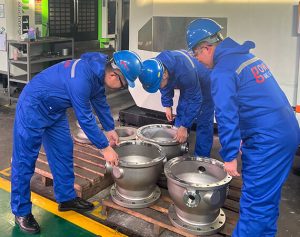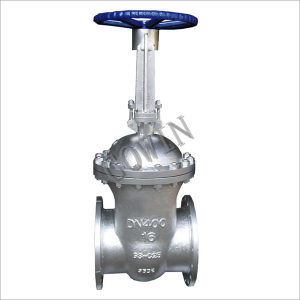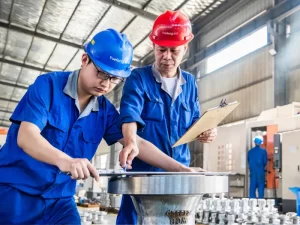Pneumatic ball valve installation requires proper alignment, secure mounting, and connection to an appropriate air supply.
Ensuring these steps guarantees efficient operation and longevity.
A systematic approach to installation and regular maintenance, including inspections and cleaning, ensures optimal performance and reduces the risk of valve failure.
What is the proper way to install a pneumatic actuated ball valve?
Step 1: Gather Tools and Materials
Ensure you have all necessary tools and materials, including wrenches, screwdrivers, mounting brackets, air supply lines, and the pneumatic ball valve.
Step 2: Check Alignment
Proper alignment is crucial to avoid undue stress on the valve and connected pipes. Use alignment tools to ensure the valve is correctly positioned.
Step 3: Secure Mounting
Attach Mounting Brackets
Secure the valve to its mounting bracket or support structure using bolts. Ensure it is firmly in place to prevent movement during operation.
Tighten Connections
Connect the valve to the pipeline, ensuring all connections are tight and leak-free. Use appropriate sealing materials, such as PTFE tape, for threaded connections.
Check Actuator Position
Ensure the actuator is properly aligned with the valve stem and that it can move freely without obstruction.
Step 4: Connect Air Supply
Install Air Lines
Connect the air supply lines to the actuator. Ensure that the air supply pressure matches the actuator’s requirements.
Test for Leaks
After connecting the air supply, test the system for leaks by applying air pressure and checking all connections with soapy water or a leak detection solution.
Adjust Air Pressure
Set the air pressure regulator to the recommended level for the valve and actuator to ensure proper operation.
How do you inspect an air operated ball valve?
Step 1: Visual Inspection
Examine External Condition
Look for signs of wear, corrosion, or damage on the valve body, actuator, and connections.
Check for Leaks
Inspect all connections and seals for any signs of leakage. Use a leak detection solution if necessary.
Inspect Actuator
Ensure the actuator is securely mounted and shows no signs of wear or damage.
Step 2: Functional Testing
Operate the Valve
Open and close the valve several times to ensure smooth operation. Listen for any unusual noises that may indicate internal issues.
Check Actuation Speed
Ensure the valve opens and closes within the expected time frame. Slow or sluggish movement may indicate air supply issues or internal mechanical problems.
Verify Position Indication
Check that the valve position indicator accurately reflects the valve’s open or closed status.
Step 3: Detailed Examination
Inspect Seals and Gaskets
Look for wear or damage on seals and gaskets, and replace them if necessary.
Check for Debris
Inspect the valve interior for any debris or buildup that could affect operation.
Review Actuator Function
Ensure the actuator components, such as springs and diaphragms, are in good condition and functioning correctly.
What is the first step in the servicing of pneumatic ball valves?
The first step in servicing pneumatic ball valves is to depressurize and isolate the valve. This involves shutting off the air supply to the actuator and releasing any remaining pressure in the system.
Next, isolate the valve from the process by closing upstream and downstream shut-off valves and safely relieving any trapped pressure within the valve body.
Ensuring the valve is fully depressurized and isolated is crucial to avoid accidents and injuries during servicing.
What maintenance is required for a air actuated ball valve?
Step 1: Regular Inspection
Conduct periodic visual inspections to check for signs of wear, damage, or leaks.
Step 2: Lubrication
Lubricate moving parts, such as the valve stem and actuator components, to ensure smooth operation.
Step 3: Seal and Gasket Replacement
Regularly inspect and replace seals and gaskets to prevent leaks and maintain proper sealing.
Step 4: Cleaning
Clean the valve internals to remove any buildup of debris or contaminants that could affect performance.
Step 5: Testing
Perform functional tests to ensure the valve operates correctly and responds accurately to control signals.
Step 6: Calibration
Periodically calibrate the actuator to maintain accurate positioning and control.
Do pneumatic operated ball valves need lubrication?
Yes, pneumatic-operated ball valves require lubrication to ensure smooth operation and prolong the lifespan of the moving parts.
Lubrication helps to reduce friction between the valve stem and seals, preventing wear and ensuring consistent performance.
Use appropriate lubricants recommended by the valve manufacturer, and apply them during regular maintenance to keep the valve in optimal condition.
How to clean a pneumatic actuator ball valve?
Step 1: Depressurize and Isolate
- Shut Off Air Supply: Disconnect the air supply to the actuator.
- Isolate the Valve: Close upstream and downstream shut-off valves to isolate the valve from the process.
- Relieve Pressure: Safely relieve any trapped pressure within the valve body.
Step 2: Disassemble the Valve
- Remove Actuator: Disconnect the actuator from the valve stem and remove it from the valve body.
- Disassemble Valve Components: Carefully remove the valve body, ball, and seals. Follow the manufacturer’s guidelines to avoid damaging any parts.
- Inspect Components: Check for wear, damage, or buildup on the ball, seats, and seals.
Step 3: Clean and Reassemble
- Clean Components: Use appropriate cleaning solutions to remove debris, buildup, and contaminants from the valve components.
- Dry and Inspect: Ensure all components are thoroughly dried and inspect them again for any damage or wear.
- Reassemble Valve: Reassemble the valve components, ensuring proper alignment and secure fitting. Reattach the actuator to the valve stem.
- Test Valve: Reconnect the air supply and test the valve to ensure it operates correctly and there are no leaks.
What support does Gowin provide as a pneumatic ball valve manufacturer?
Gowin, a leading valve manufacturer since 2007, provides comprehensive support for its pneumatic ball valves, ensuring optimal performance and customer satisfaction.
Here’s how Gowin supports its clients:
- Technical Assistance: Gowin offers expert technical support to help with valve selection, installation, and troubleshooting. Their team of engineers is available to assist with any technical queries or issues.
- Quality Assurance: Gowin’s valves are manufactured to the highest standards, with ISO9001 & ISO14001 certifications and compliance with industry standards such as API6D, TS, OHSAS45001, Fire Safety API607 & API6FA.
- Maintenance Services: Gowin provides maintenance services, including regular inspections, lubrication, and component replacement, to ensure the longevity and reliability of their valves.
- Training and Resources: Gowin offers training sessions and detailed documentation to educate clients on the proper installation, operation, and maintenance of their pneumatic ball valves.
- Customer Support: A dedicated customer support team is available to address any concerns or questions, ensuring timely and effective resolution of issues.
Gowin’s commitment to quality, innovation, and customer service has positioned it as a trusted partner for industries worldwide, providing reliable solutions for critical applications.








